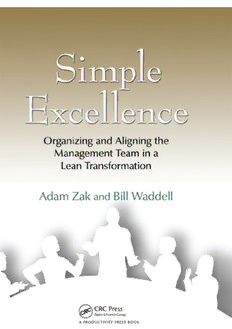Table Of ContentSimple
Excellence
Organizing and Aligning the
Management Team in a
Lean Transformation
Adam Zak and Bill Waddell
2
3
Productivity Press
Taylor & Francis Group
270 Madison Avenue
New York, NY 10016
© 2011 by Taylor and Francis Group, LLC
Productivity Press is an imprint of Taylor & Francis Group,
an Informa business
No claim to original U.S. Government works
International Standard Book Number: 978-1-4398-8519-2
(ePub)
This book contains information obtained from authentic and
highly regarded sources. Reasonable efforts have been made
to publish reliable data and information, but the author and
publisher cannot assume responsibility for the validity of all
materials or the consequences of their use. The authors and
publishers have attempted to trace the copyright holders of all
material reproduced in this publication and apologize to
copyright holders if permission to publish in this form has not
been obtained. If any copyright material has not been
acknowledged please write and let us know so we may rectify
in any future reprint.
Except as permitted under U.S. Copyright Law, no part of this
book may be reprinted, reproduced, transmitted, or utilized in
any form by any electronic, mechanical, or other means, now
known or hereafter invented, including photocopying,
microfilming, and recording, or in any information storage or
4
retrieval system, without written permission from the
publishers.
For permission to photocopy or use material electronically
from this work, please access www.copyright.com
(http://www.copyright.com/) or contact the Copyright
Clearance Center, Inc. (CCC), 222 Rosewood Drive, Danvers,
MA 01923, 978-750-8400. CCC is a not-for-profit
organization that provides licenses and registration for a
variety of users. For organizations that have been granted a
photocopy license by the CCC, a separate system of payment
has been arranged.
Trademark Notice: Product or corporate names may be
trademarks or registered trademarks, and are used only for
identification and explanation without intent to infringe.
Visit the Taylor & Francis Web site at
http://www.taylorandfrancis.com
and the Productivity Press Web site at
http://www.productivitypress.com
5
Contents
Preface
Authors
Chapter 1 A Different Way of Managing
SECTION I THINKING DIFFERENTLY
Chapter 2 The Mom-and-Pop Theory of Management
Chapter 3 It’s All about Value
Chapter 4 The High Cost of Poor Cost Accounting
Chapter 5 Can We Find a Few Righteous People?
6
Chapter 6 People
Chapter 7 Channels and Chains
Chapter 8 You Gotta Go with the Flow
SECTION II MANAGING DIFFERENTLY
Chapter 9 Getting Sales and Marketing into the Game
Chapter 10 Value-Stream Structures
Chapter 11 Simple Accounting
Chapter 12 The Roadmap from Chain to Channel
Chapter 13 Scheduling the Factory
Chapter 14 Purchasing
Chapter 15 Quality Management
7
Chapter 16 Sales, Operations, and Financial Planning
Chapter 17 Pricing to Win
Chapter 18 Capital Investment
Chapter 19 Performance Metrics
Chapter 20 Wrapping It Up
Index
8
Preface
For over 25 years we have been working in and around
manufacturing. Our careers began before Jim Womack, Dan
Jones, and Dan Roos coined the term Lean manufacturing in
their watershed book, The Machine that Changed the World,
and we have seen the global manufacturing landscape
transform as companies have worked to understand and apply
the principles of Lean thinking. We would like to think that
we have even influenced the evolution of Lean a bit through
our work and our writing.
We have seen activity-based costing come into and pass out
of vogue and the theory of constraints become one of the
basic principles of manufacturing. We have witnessed
manufacturing quality management evolve as a result of the
ideas behind statistical process control (SPC), Six Sigma, and
Deming’s plan–do–check–act (PDCA) principles.
Technology—especially information and communications
technology—has enormously impacted manufacturing over
the course of our careers. And, of course, we have observed
the effects of globalization.
Throughout this period of dramatic change and under the
onslaught of new ideas, we have had a chance to observe
9
some very successful companies. Unfortunately, during this
time too many great manufacturing companies have dwindled
or died out all together. Most companies are somewhere in
between, trying to figure it all out. This book is written for the
management of those companies. Having had a chance to see
several very successful manufacturing companies in action,
we have had the great fortune of learning some very
important lessons. Our purpose here is to share them.
A couple of overarching principles are woven throughout this
book. They keep coming up because they are common among
all of the very well-managed companies we have studied and
with which we have worked, and strike us as central to their
success. First among them is the degree to which the entire
management team is engaged and involved. While most
companies are relatively compartmentalized—salespeople
sell, manufacturing people manufacture, and accounting
people account—in the best companies there’s a dramatic
difference: you need a scorecard to determine who does what
even after having spent an hour with the management team.
No one’s turf is sacred. All are involved in the entire business
and work in tightly integrated teams in just about every aspect
of the enterprise. This gives them a powerful synergy of
knowledge, talents, and ideas.
When we look at the evolution of Lean manufacturing, most
of the literature and most of the effort have been aimed
exclusively at manufacturing operations (hence Lean
manufacturing, we suppose). On top of the Lean factory
literature, there has been quite a bit aimed at the chief
executive officer (CEO) level concerning Lean philosophy
and Lean leadership. In recent years accounting, product
innovation, and engineering have been slowly added into the
10

